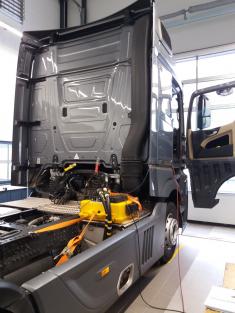
Time and Venue
The United Nations Economic Commission for Europe organized a demonstration on the “detection of manipulations of vehicle emission after-treatment systems", with the support of the Danish Road Traffic Inspectorate and Dekra, in conjunction with the eighty-fifth annual session of the Inland Transport Committee (ITC).
Background
The UNECE Inland Transport Committee is the UN platform for Inland Transport and custodian of 59 legal instruments covering road, rail, inland waterways, border crossing facilitation and intermodal transport.
ITC activities cover among others, the segment of regulatory activities for the certification and testing of vehicles. This falls within the merits of the World Forum for Harmonization of Vehicle Regulations, WP.29, a subsidiary body of ITC.
This year’s demonstration will focus on tools that have been specially designed to address environmental concerns and support the implementation of vehicle regulations.
In compliance with the high exhaust emission requirements of the type approval regulations, vehicle manufacturers are implementing measures to reduce the highly toxic nitrogen oxides (NOx). For heavy vehicles in particular, Selective Catalytic Reduction (SCR) catalysts are commonly used as the most effective technical solution and are therefore installed in practically every modern commercial vehicle and in the majority of modern passenger cars.
However, since these nitrogen oxide reduction measures consume a reagent liquid, usually sold as AdBlue, during operation (which must be refuelled in addition to diesel), the systems are manipulated to save operating costs and thus rendered ineffective. Several manipulation systems (software and hardware solutions) are easily available on the Internet for all common commercial vehicles. With very little cost and time (hardware costs ~200€ and installation ~2h) the highly effective SCR systems can be deactivated.
The systems, which normally remove over 90% of the toxic nitrogen oxide emissions from the exhaust gas, become ineffective.
In the course of profit maximization, drastic consequences for health and the environment are thus accepted by manipulating the SCR system.
To counter these tactics that help circumvent regulations, in a project with the Danish Road Traffic Inspectorate, Dekra has developed a tool that will enable accurate monitoring of the highly toxic nitrogen oxides (NOx).
Purpose
The demonstration illustrated both manipulation devices and how such manipulations may be easily detected by enforcement bodies using new technology. Ultimately this will contribute to a greener environment.
The purpose of this demonstration was to engage in discussions related to the enforcement of vehicle regulations and the reduction of harmful emissions.
These discussions contributed to the bigger role of achieving a sustainable future mobility system and contributing to achieving SDGs target 3.9 on reduction of harmful air pollutants and SDG 13 Climate Action, as well as the Paris Agreement on Climate Change.

